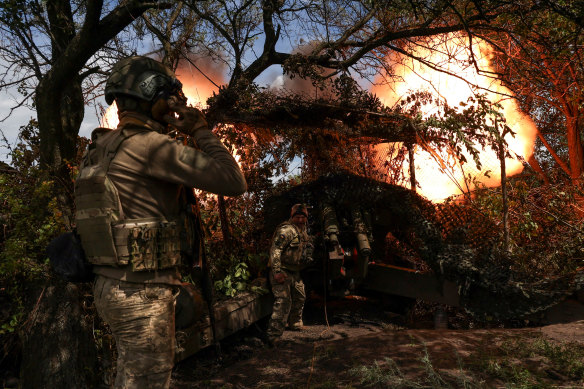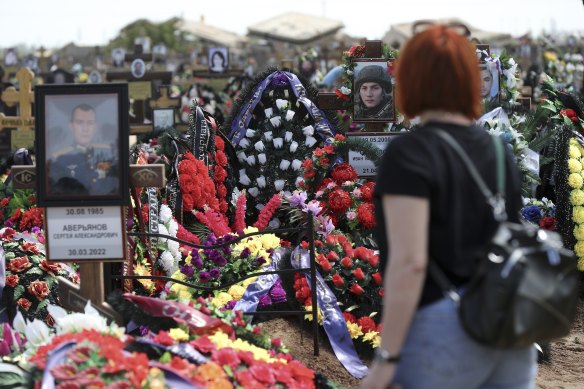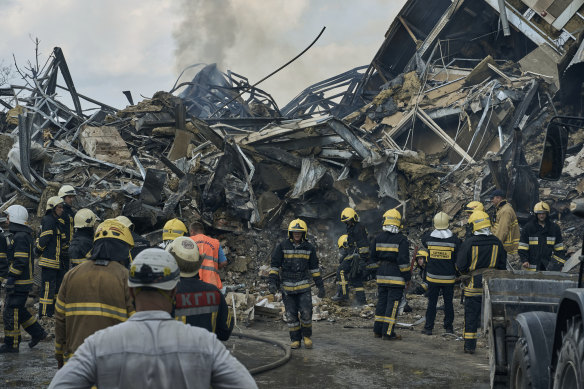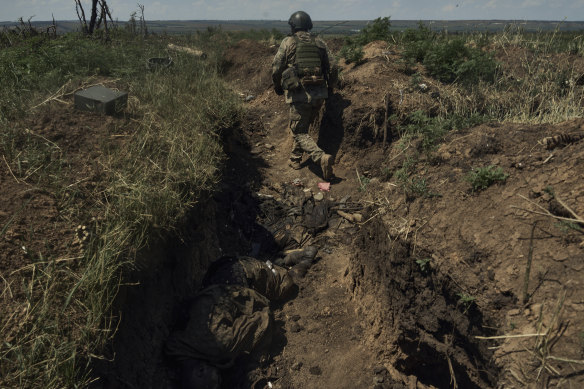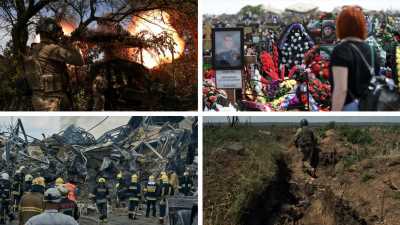
Save articles for later
Add articles to your saved list and come back to them any time.
Counting casualties in war is a tricky business. Reports from the ground are largely estimated based on probability, while constrained access to violent conflict zones can cloud an accurate picture.
And when both sides want to magnify their wins while playing down their losses, the task is even harder.
More than 500 days after Russian forces launched their illegal invasion of Ukraine, the number of soldiers killed or injured on both sides has been said to run into the hundreds of thousands.
Ukrainians fire a D-20 howitzer at Russian troops from a position near Bakhmut in July.Credit: Reuters
Highly classified US military and intelligence documents leaked and discovered on an online gaming platform earlier this year suggested that up to 354,000 Ukrainian and Russian soldiers had been killed or injured since February last year.
The same documents estimated between 15,500-17,500 Ukrainian troops had been killed and 109,000-113,500 wounded in action. Among Russian forces, 35,500-43,000 are believed to have been killed in action while 154,000-180,000 are considered wounded, Reuters reported in April.
A woman visits the graves of Russian soldiers killed in Ukraine at a cemetery in Volzhsky, outside Volgograd, Russia, last year. Some experts say that Europe’s largest conflict since World War II could drag on for years. Credit: AP
Highlighting the difficulty at tracking Russian casualties, the independent US think the Centre for Strategic and International Studies has suggested a much higher number -putting the figure as approximately 60,000 to 70,000 combat fatalities for Russia in the first year of the conflict. Their figures include Russian soldiers, secret service members, militia fighters, and members of private military groups such as the Wagner Group. The CSIS estimates the figure rises to 200,000 to 250,000 if you include the wounded, and say that while some authoritarian regimes are willing to accept high casualties, the numbers are unprecedented for post-World War II Russia.
The UK Ministry of Defence in February claimed approximately 40,000 to 60,000 Russians had likely been killed in the war.
Retired Australian Defence Force major general Mick Ryan said casualty counts from wars of the past 200 years have always been rough approximations of what happened, revealing “a window of probability,” rather than exact numbers.
“Because in these kinds of conflicts, there’s a percentage of people who are missing. Missing can encompass being a prisoner of war, having been killed in such a way your body is obliterated, or you’ve fallen somewhere, and they are yet to recover you – and won’t for some time,” he said.
“There’s uncertainty that’s on both sides, and technology does not help, no matter what anyone thinks.”
Fighting escalated this week with a major Russian attack in Odesa destroying historic sites and critical infrastructure.Credit: AP
With Russia and Ukraine eager to thwart the other from grasping a good sense of their military position, they have largely kept quiet on counts of their own military casualties.
The Institute for the Study of War, an independent public policy think tank in Washington, says tolls in a conflict are intentionally opaque to obscure the current military potential and what is and is not working.
There is also an incentive for commanders and political leaders to assess down their side’s own losses, while assessing up the enemy side’s losses, a spokesman for the institute suggests.
Ryan, who served in the ADF for more than 35 years and was commander of the Australia Defence College, said operational security was a major driver of the kind of information governments release, including numbers of killed, wounded, missing and prisoners of war.
“We see that every single day on [Ukraine’s] social media and in their Facebook daily operational updates,” Ryan said.
“They update the count of about 20 different measures, including soldiers killed, tanks, infantry, fighting vehicles, aircraft…it’s part of this strategic influence battle both are fighting.”
Ryan said the scale of death in Ukraine could not be compared to protracted conflicts in Iraq or Afghanistan, which were historically “low tempo” or low casualty wars for military forces.
A Ukrainian soldier in a recently captured Russian trench with deceased Russian soldiers, on the frontline near Bakhmut, Donetsk region.Credit: AP
“You really have to go back to something like the Korean War […] the mass forces used on both sides, to get a sense of this.”
A data collaboration project by two independent Russian media outlets and a data scientist at Tübingen University, Germany, in July suggested nearly 50,000 Russian men have died in the war.
The analysis by Mediazona, Meduza and data scientist Dmitry Kodak probed Russian government inheritance records and official mortality data to apply a statistical method used widely during the COVID-19 pandemic to compute excess mortality.
Calculating deaths by excess mortality was popularised during the pandemic because many nations lacked the data and resources to accurately report COVID-19 deaths. Excess mortality is defined as the difference in the total number of deaths in a crisis compared to those expected under normal conditions.
In the pandemic, excess mortality accounted for the total number of deaths directly attributed to the virus, as well as the indirect impact from things like disruption to essential health services or travel disruptions.
Kobak, who applied excess mortality when calculating COVID-related deaths in Russia during the pandemic, said the same concept could calculate war casualties.
Using Russian government data, Kobak said the project estimated how many more men under the age of 50 died between February 2022 and May 2023 in comparison to pre-war years.
“We wanted to look at young males and compare how the deaths in this specific age group and in this specific gender went up compared to…the deaths in young females of the same age. Because at least in Russia, all war casualties are men. So, this separates very cleanly,” he said.
Journalists from Mediazona, BBC Russia and volunteers had earlier obtained records of inheritance cases filed with Russian authorities detailing probate applications for more than 11 million people who died between 2014 and May 2023.
Their analysis showed 25,000 more inheritance cases were opened in 2022 for males aged 15 to 49 than expected, AP reported. By the end of May, the number of excess cases had shot up to 47,000.
A Meduza journalist, who requested anonymity because their work for the news outlet is punishable by up to 15 years’ jail, said the project highlighted the importance of an open-source intelligence “revolution” in the past decade.
“It’s crucial to rely on objective data that can be proved or reproduced by independent researchers,” they said.
“This allows us to view the conflict in a completely different light, where [we are] not relying exclusively on intelligence or the statements of both sides of the conflict, but actually using objective data.”
Asked about the study last month, Kremlin spokesman Dmitry Peskov said mortality figures released by Russia’s Defence Ministry were “the only ones who have that prerogative”. Peskov has also dismissed US estimates of Russian casualties as incorrect.
Both Medizona and Meduza are banned in Russia, where readers can only access the sites by VPN.
As military watchers confront the difficulties of calculating lives lost on the frontline, aid and advocacy groups face similar challenges in their work to monitor civilian deaths.
The most recent figures from the UN Human Rights Monitoring Mission in Ukraine estimate about 9200 civilians have been killed since February 24 last year, with a further 16,300 wounded.
Krzysztof Janowski, spokesman for the mission, said the conflict in Ukraine was unique to other wars because the UN was unable to work on both sides of the confrontation lines.
“Even in Bosnia during the darkest hours of the war [1992-95] and in Syria, the UN was able to cross the confrontation line and work on both sides. In Ukraine the UN is constrained to one side – the side controlled by Ukraine,” he said.
“Every civilian death is one death too many.”
The highest number of civilian casualties accrued in March and April last year, the first months after the Russian invasion, the UN mission has reported. Casualties then stabilised before starting to recede by the end of 2022, with a slight uptick in the past two months, Janowski said.
Get a note directly from our foreign correspondents on what’s making headlines around the world. Sign up for the weekly What in the World newsletter here.
Most Viewed in World
From our partners
Source: Read Full Article
